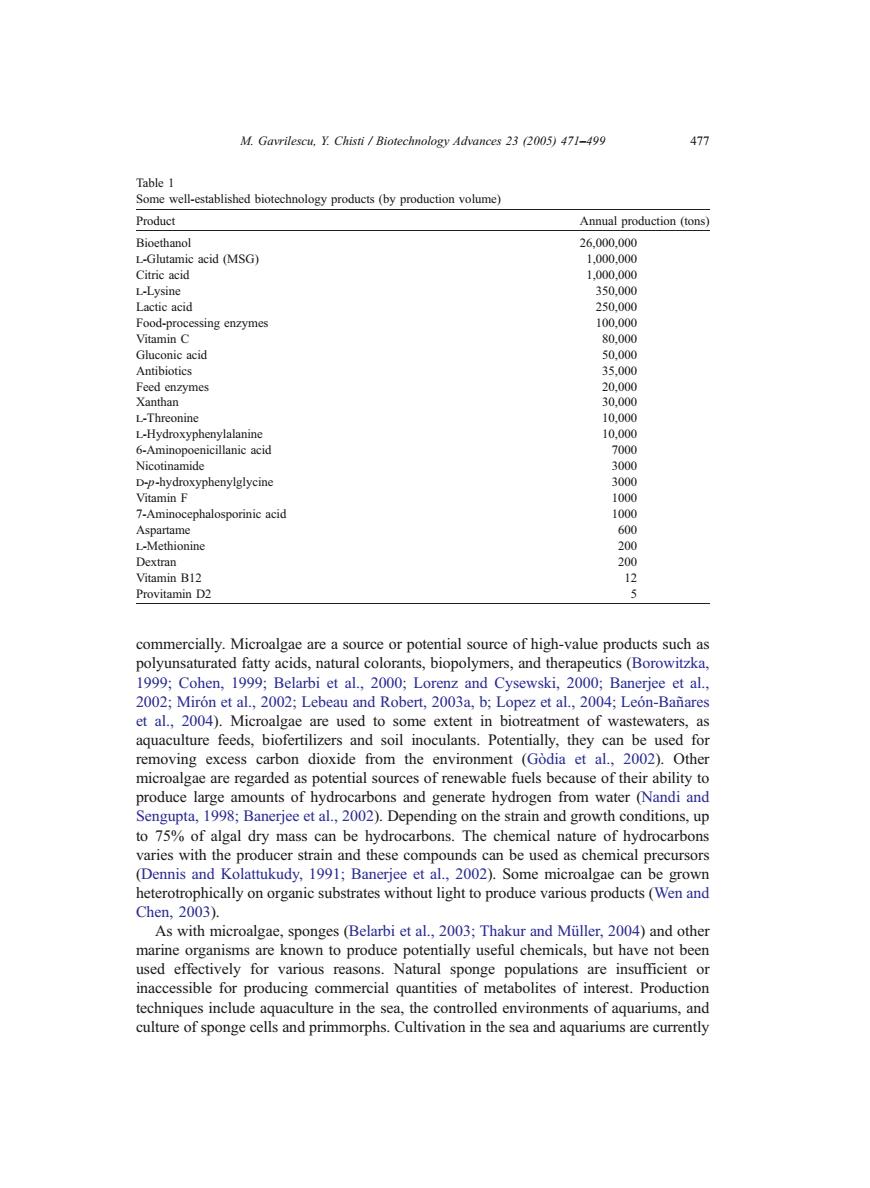正在加载图片...

M.Gavrilescu,Y.Chisti Biotechnology Advances 23 (2005)471-499 477 Table 1 Some well-established biotechnology products (by production volume) Product Annual production (tons) Bioethanol 26,000.000 L-Glutamic acid (MSG) 1.000.000 Citric acid 1.000.000 L-Lysine 350.000 Lactic acid 250.000 Food-processing enzymes 100.000 Vitamin C 80,000 Gluconic acid 50.000 Antibiotics 35.000 Feed enzymes 20.000 Xanthan 30.000 L-Threonine 10.000 L-Hydroxyphenylalanine 10,000 6-Aminopoenicillanic acid 7000 Nicotinamide 3000 D-p-hydroxyphenylglycine 3000 Vitamin F 1000 7-Aminocephalosporinic acid 1000 Aspartame 600 L-Methionine 200 Dextran 200 Vitamin B12 12 Provitamin D2 5 commercially.Microalgae are a source or potential source of high-value products such as polyunsaturated fatty acids,natural colorants,biopolymers,and therapeutics(Borowitzka, 1999;Cohen,1999;Belarbi et al.,2000;Lorenz and Cysewski,2000;Banerjee et al., 2002;Miron et al.,2002;Lebeau and Robert,2003a,b;Lopez et al.,2004;Leon-Banares et al.,2004).Microalgae are used to some extent in biotreatment of wastewaters,as aquaculture feeds,biofertilizers and soil inoculants.Potentially,they can be used for removing excess carbon dioxide from the environment (Godia et al.,2002).Other microalgae are regarded as potential sources of renewable fuels because of their ability to produce large amounts of hydrocarbons and generate hydrogen from water (Nandi and Sengupta,1998;Banerjee et al.,2002).Depending on the strain and growth conditions,up to 75%of algal dry mass can be hydrocarbons.The chemical nature of hydrocarbons varies with the producer strain and these compounds can be used as chemical precursors (Dennis and Kolattukudy,1991;Banerjee et al.,2002).Some microalgae can be grown heterotrophically on organic substrates without light to produce various products(Wen and Chen.2003). As with microalgae,sponges(Belarbi et al.,2003;Thakur and Muiller,2004)and other marine organisms are known to produce potentially useful chemicals,but have not been used effectively for various reasons.Natural sponge populations are insufficient or inaccessible for producing commercial quantities of metabolites of interest.Production techniques include aquaculture in the sea,the controlled environments of aquariums,and culture of sponge cells and primmorphs.Cultivation in the sea and aquariums are currentlycommercially. Microalgae are a source or potential source of high-value products such as polyunsaturated fatty acids, natural colorants, biopolymers, and therapeutics (Borowitzka, 1999; Cohen, 1999; Belarbi et al., 2000; Lorenz and Cysewski, 2000; Banerjee et al., 2002; Miro´ n et al., 2002; Lebeau and Robert, 2003a, b; Lopez et al., 2004; Leo´ n-Ban˜ares et al., 2004). Microalgae are used to some extent in biotreatment of wastewaters, as aquaculture feeds, biofertilizers and soil inoculants. Potentially, they can be used for removing excess carbon dioxide from the environment (Go`dia et al., 2002). Other microalgae are regarded as potential sources of renewable fuels because of their ability to produce large amounts of hydrocarbons and generate hydrogen from water (Nandi and Sengupta, 1998; Banerjee et al., 2002). Depending on the strain and growth conditions, up to 75% of algal dry mass can be hydrocarbons. The chemical nature of hydrocarbons varies with the producer strain and these compounds can be used as chemical precursors (Dennis and Kolattukudy, 1991; Banerjee et al., 2002). Some microalgae can be grown heterotrophically on organic substrates without light to produce various products (Wen and Chen, 2003). As with microalgae, sponges (Belarbi et al., 2003; Thakur and Mu¨ller, 2004) and other marine organisms are known to produce potentially useful chemicals, but have not been used effectively for various reasons. Natural sponge populations are insufficient or inaccessible for producing commercial quantities of metabolites of interest. Production techniques include aquaculture in the sea, the controlled environments of aquariums, and culture of sponge cells and primmorphs. Cultivation in the sea and aquariums are currently Table 1 Some well-established biotechnology products (by production volume) Product Annual production (tons) Bioethanol 26,000,000 l-Glutamic acid (MSG) 1,000,000 Citric acid 1,000,000 l-Lysine 350,000 Lactic acid 250,000 Food-processing enzymes 100,000 Vitamin C 80,000 Gluconic acid 50,000 Antibiotics 35,000 Feed enzymes 20,000 Xanthan 30,000 l-Threonine 10,000 l-Hydroxyphenylalanine 10,000 6-Aminopoenicillanic acid 7000 Nicotinamide 3000 d-p-hydroxyphenylglycine 3000 Vitamin F 1000 7-Aminocephalosporinic acid 1000 Aspartame 600 l-Methionine 200 Dextran 200 Vitamin B12 12 Provitamin D2 5 M. Gavrilescu, Y. Chisti / Biotechnology Advances 23 (2005) 471–499 477